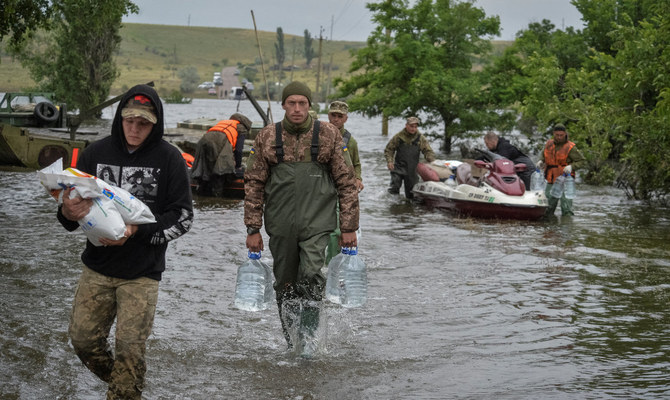Kerry Boyd Anderson
The collapse of the Nova Kakhovka dam in Ukraine last week highlighted the role of water in warfare. The use of water as a weapon has a history stretching back into ancient times and it continues today. As climate change intensifies water scarcity, the value of water is likely to increase, thus incentivizing its further use in conflict.
Damage to water infrastructure can be an accidental consequence of war or an intentional act. For example, the Nova Kakhovka dam might have collapsed due to damage sustained during the conflict combined with a lack of regular maintenance since falling under Russian control, or it might have been used as a weapon, intentionally destroyed to cause massive flooding. Russia and Ukraine have blamed each other. While there is a lack of publicly available evidence to be certain, it appears likely that Russian forces destroyed it in order to flood an area where Ukraine might launch a military offensive. When water is deployed as a weapon, it can take several forms. From ancient times to today, destroying or poisoning water sources has been a common tactic. Wells have been poisoned in order to complete a siege, weaken opponents or punish a population. Depriving populations or military forces of water is another tool. From the Assyrians to Daesh, combatants have destroyed wells for military purposes. In other cases, canals, rivers or other water sources are diverted. In one recent example, after Russia’s takeover of Crimea in 2014, Ukraine blocked a canal that carried much of Crimea’s water from the Kakhovka reservoir. Russian forces removed the blockage following its 2022 invasion.
Intentionally flooding an area in order to slow a military advance, damage wartime industry or force soldiers or civilians out into the open also has a long history. Last month marked the 80th anniversary of Operation Chastise, also known as the “Dambusters” raid, a British operation during the Second World War intended to destroy three German dams in the Ruhr valley. Using a special type of bomb, the British forces successfully destroyed two of the three dams, causing flooding that killed hundreds of people, while doing less damage to Germany’s industrial capacity than expected. In another of many examples throughout history, Belgian forces intentionally flooded part of the Yser river in order to slow a German advance during the First World War. Throughout the war between Ukraine and Russia, Russian forces have repeatedly attacked Ukrainian water infrastructure, while Ukraine intentionally flooded some areas to slow Russia’s initial invasion last year. The Nova Kakhovka dam collapse is probably a new addition to the list of such incidents, though on a larger scale than previously seen in this war.
Sometimes, weaponizing water serves both military and political goals. Israel has restricted water resources to Palestinians as part of larger efforts to displace local populations and undermine Palestinian economic development. The Syrian regime repeatedly used water shortages against civilians and combatants during the Syrian civil war. Upstream states can use water – and the implicit threat of cutting or reducing its flow – as leverage when negotiating with downstream states about a wide range of issues. While history is replete with examples of the strategic and tactical use of water in war and politics, it is unclear whether weaponizing water is often very effective. For example, if Russia destroyed the Nova Kakhovka dam, many experts say it is unlikely to significantly undermine Ukraine’s counteroffensive, while it affected both Russian and Ukrainian-held territory and, according to reports, killed some Russian soldiers.
The recent anniversary of the so-called Dambusters raid highlighted analysis that suggests the raid was far less effective in countering Germany’s war efforts than planned, while coming at a significant cost to British forces and resources. While there are examples of using water to successfully achieve military goals, any force that tries to unleash water against an enemy cannot fully control the water and often faces the risk of blowback onto its own soldiers or assets and the risk of missing its intended target. Water can be used as a weapon almost anywhere in the world, but some regions are particularly prone to the weaponization of water. The Pacific Institute has a list of incidents involving water in conflict that goes back to ancient times. Drawing on the data from 2018 through March 2022, the Middle East and North Africa stands out with the most incidents, followed by the Russia-Ukraine war and then sub-Saharan Africa. It is unsurprising that the world’s most arid region also has the highest number of recent incidents involving water in conflict, and climate change threatens to worsen that record. Efforts to address and adapt to climate change should take the problem of water in conflict seriously.
More broadly, the international community needs to place greater emphasis on addressing the role of water in conflict. Under the additional protocols to the Geneva Conventions, attacks on water infrastructure such as dams can constitute a war crime, particularly if they cause significant harm to civilians. As with all forms of international law, however, much depends on how the international community responds and enforces consequences for such violations. The tragic results of the Nova Kakhovka dam collapse should bring greater attention to the role that weaponizing water is likely to play in the future.







